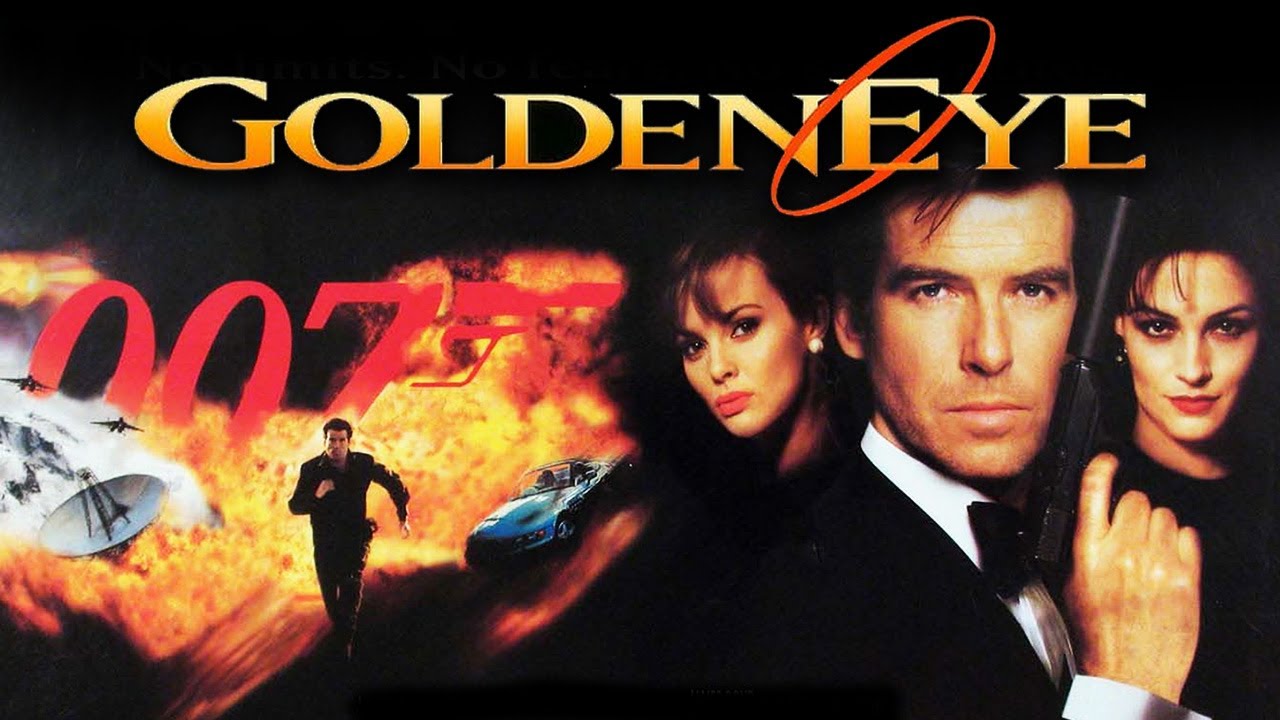GoldenEye (1995, Dir. Martin Campbell):
When I started to write these books in 1952, I wanted to find a name that didn’t have any sort of romantic overtones… I wanted a really flat, quiet name, and one of my bibles out here [in Goldeneye, Jamaica] is James Bond’s Birds of the West Indies, which is a very famous ornithological book indeed. And I thought, James Bond, well that’s a pretty quiet name, so I simply stole it and used it.
— Ian Fleming, 1964
The Fleming Villa along with its satellite cottages, Pool House and Sweet Spot is all about privacy. Your own private beach, your own pool, and tropical garden. Located 20 minutes east of Ocho Rios and an 8-minute drive from Ian Fleming International Airport this 5 bedroom villa was Ian Fleming’s Jamaican retreat and where he wrote all 14 of the James Bond novels. The villa features the original three bedrooms and two stand alone guest cottages (sleeps up to 10). The villa comes with its own dedicated staff that includes a butler, housekeeper and cook.
— www.theianflemingvilla.com
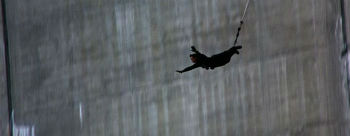 The curtain rises (or more accurately, the gunbarrel iris widens): A high crane shot of a man sprinting across the top of a dam. No explication is provided about who the man is, what he’s doing, why he’s there. Tethering himself to a bungee cord, the man perches himself at the dam’s edge as the camera spins above him, all the better for us to appreciate the chasm that spreads out beneath. Then the jump, the body in free-fall for a good thirty seconds, with only the whisper of wind on the soundtrack. It’s an arresting moment and also a statement of intent: Invigoration is back. Sensation for the sake of sensation is back. Bond is back.
The curtain rises (or more accurately, the gunbarrel iris widens): A high crane shot of a man sprinting across the top of a dam. No explication is provided about who the man is, what he’s doing, why he’s there. Tethering himself to a bungee cord, the man perches himself at the dam’s edge as the camera spins above him, all the better for us to appreciate the chasm that spreads out beneath. Then the jump, the body in free-fall for a good thirty seconds, with only the whisper of wind on the soundtrack. It’s an arresting moment and also a statement of intent: Invigoration is back. Sensation for the sake of sensation is back. Bond is back.
As far as opening gambits go, the bungee jump that opens GoldenEye ranks among the Bond series’ best. It deliberately hearkens back to the franchise’s salad days, when the primary object was to start big and go bigger from there. Six years had passed since Licence to Kill, much had changed, and it was essential for Bond to re-announce his presence with authority. He was now in the hands of MGM, the Berlin Wall had tumbled, and audiences were into more fanciful stuff: CGI dinosaurs in Jurassic Park, Tom Hanks receiving a medal from Richard Nixon in Forrest Gump. Still, the appetite for spy cinema had never gone completely away. Arnold Schwarzenegger’s True Lies (1994) had appropriated the excesses of some of the earlier Bond movies (Ah-nold even pops out of a wet suit in a tuxedo a la Connery in Goldfinger), while Tom Clancy’s Jack Ryan had taken its cue from the later Bond entries, locating its hero in the geopolitical morass of the times (non-state terrorists, South American drug lords). Bond was never really a Cold Warrior — glance over the plots for the previous sixteen 007 movies, and you’ll see that he seldom if ever butted heads with the Russkies — but much of his appeal was derived from the Cold War milieu. What could be sexier, or more liberating, than jetting all around the Western hemisphere with impunity, preserving free-market consumerism with a smirk and a martini? Timothy Dalton’s Bond movies, for whatever reason, had failed to connect with audiences, and there was no guarantee that Bond would regain his magic touch in this new era. Where could 007 go now that the USSR had become just another name in a history book?
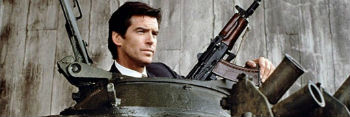 Bond’s cultural currency, or lack of it, would become one of the major themes of GoldenEye. With Albert Broccoli in semi-retirement, his daughter Barbara and stepson Michael Wilson had stepped to the fore, and you can sense their trepidation about what to do with the Bond brand throughout the movie. On the one hand, they had finally scored Pierce Brosnan as the new 007, nine years after they had lost him. (Cheekily, the film sets its pre-title sequence back in 1986, in effect erasing the Dalton era.) Blessed with the features of a catalog model, Brosnan couldn’t have looked more like a classic Bond if he tried, which indicated that a vintage-style movie was the way to go. On the other hand, it would have been foolhardy to do an old-time 007 adventure without at least acknowledging that things weren’t quite the same as they had been in 1962. As with Dalton’s The Living Daylights, a “generic” Bond script was produced in the early going (by Michael France and Jeffrey Caine) that would afford a new actor room to bring his own interpretation to the role, but this time an extra layer would be supplied by screenwriter Bruce Feirstein, who was given one overriding dictum: The world has changed, but James Bond has not. For the first time, Bond as a character would be self-aware about his place in the grand scheme, and Feirstein seemed to be a logical choice to handle the transition; this after all was the man who had written Real Men Don’t Eat Quiche (take that, Roger Moore).
Bond’s cultural currency, or lack of it, would become one of the major themes of GoldenEye. With Albert Broccoli in semi-retirement, his daughter Barbara and stepson Michael Wilson had stepped to the fore, and you can sense their trepidation about what to do with the Bond brand throughout the movie. On the one hand, they had finally scored Pierce Brosnan as the new 007, nine years after they had lost him. (Cheekily, the film sets its pre-title sequence back in 1986, in effect erasing the Dalton era.) Blessed with the features of a catalog model, Brosnan couldn’t have looked more like a classic Bond if he tried, which indicated that a vintage-style movie was the way to go. On the other hand, it would have been foolhardy to do an old-time 007 adventure without at least acknowledging that things weren’t quite the same as they had been in 1962. As with Dalton’s The Living Daylights, a “generic” Bond script was produced in the early going (by Michael France and Jeffrey Caine) that would afford a new actor room to bring his own interpretation to the role, but this time an extra layer would be supplied by screenwriter Bruce Feirstein, who was given one overriding dictum: The world has changed, but James Bond has not. For the first time, Bond as a character would be self-aware about his place in the grand scheme, and Feirstein seemed to be a logical choice to handle the transition; this after all was the man who had written Real Men Don’t Eat Quiche (take that, Roger Moore).
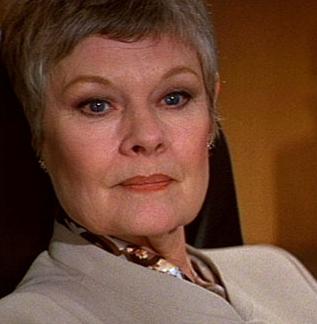 The final film thus has a bifurcated focus. In many respects it’s an unapologetic Bond movie with a capital B. Within the first fifteen minutes we see the Aston Martin DB5, Bond in a tux in a casino, a Vodka martini shaken not stirred: no fooling around here. When Brosnan says “Bond. James Bond” he gets the full heroic close-up. (As a stark contrast, when Dalton introduces himself as “Bond, James Bond” in Licence to Kill, he receives a rude brush-off from a bad guy.) At this stage of her career, Tina Turner is no Shirley Bassey, but she gives it the good old college try for the theme tune. The villain’s plot — destroy Western economies with a well-aimed electromagnetic pulse from space — is as time-honored as they come, and all the usual elements are present and accounted for: briefing by M, a visit to Q’s workshop, the good Bond girl (Izabella Scorupco’s Natalya, easily the most appealing of all of Brosnan’s leading ladies) and the bad Bond girl (Famke Janssen, going cartoonish as Xenia Onatopp, a Russian assassin who savors asphyxiating her prey between her thighs), infiltrating the baddie’s lair, explosions galore for the finale.
The final film thus has a bifurcated focus. In many respects it’s an unapologetic Bond movie with a capital B. Within the first fifteen minutes we see the Aston Martin DB5, Bond in a tux in a casino, a Vodka martini shaken not stirred: no fooling around here. When Brosnan says “Bond. James Bond” he gets the full heroic close-up. (As a stark contrast, when Dalton introduces himself as “Bond, James Bond” in Licence to Kill, he receives a rude brush-off from a bad guy.) At this stage of her career, Tina Turner is no Shirley Bassey, but she gives it the good old college try for the theme tune. The villain’s plot — destroy Western economies with a well-aimed electromagnetic pulse from space — is as time-honored as they come, and all the usual elements are present and accounted for: briefing by M, a visit to Q’s workshop, the good Bond girl (Izabella Scorupco’s Natalya, easily the most appealing of all of Brosnan’s leading ladies) and the bad Bond girl (Famke Janssen, going cartoonish as Xenia Onatopp, a Russian assassin who savors asphyxiating her prey between her thighs), infiltrating the baddie’s lair, explosions galore for the finale.
Given the rigidity of the template, Feirstein has to sneak in his snarky commentary on the state of Bond-ness through the mouths of his characters. On some level, everyone in this movie is aware of Bond as a phenomenon, and they’re handed plenty of opportunities to voice their opinion on it. The new M (Judi Dench, a masterstroke of casting) takes pleasure in castigating him for being a “sexist, misogynist dinosaur” — although heaven knows what that has to do with whether he’s an effective secret agent or not. Natalya has no problem calling him out on his macho “guns and killing” attitude — even though her character is a frightened innocent who should be currying favor with the one man who can save her from execution. Moneypenny (Samantha Bond) has clearly been taking her HR seminars, because she comes within a hair of filing a sexual harassment suit against 007. Old KGB opponent Zukovsky (Robbie Coltrane) can’t resist baiting Bond with the man’s own catchphrases: “Shaken but not stirred,” he snickers when he has Bond in his clutches. “Spare me the Freud,” Sean Bean’s villainous Alec Trevelyan sighs at Bond when the agent makes a crack about his motivations, but GoldenEye is all about putting Bond on the couch.
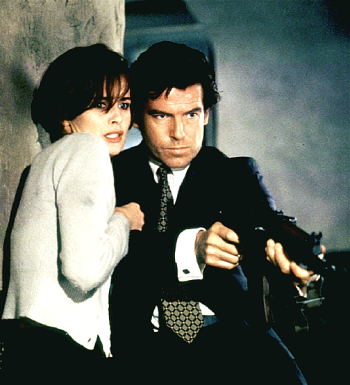 Dimitri Mishkin: So, by what means shall we execute you, Commander Bond?
Dimitri Mishkin: So, by what means shall we execute you, Commander Bond?
James Bond: What, no small-talk? No chit-chat? That’s the trouble with the world today. No one takes the time to do a really sinister interrogation anymore. It’s a lost art.
In its style and pacing, at least GoldenEye restores some of the luster of earlier Bond movies. Director Martin Campbell isn’t given a whole lot to work with — the English studio backlots are a poor substitute for St. Petersburg, where much of the film is set, and the major action setpiece is an overlong, clangy tank chase — but his vigorous framing is a breath of fresh air coming off five films’ worth of pedestrian cinematography. GoldenEye is more restrained than subsequent Brosnan Bonds, and all the better for it, especially during a climactic showdown between Bond and Trevelyan that is the best hand-to-hand combat scene in the series since the Connery days. For all of Campbell’s professionalism, though, the script’s shortcomings are difficult to overcome. The sight of Bond blasting away with a machine gun with impunity (a trend that would only grow worse in succeeding movies) is the first sign that 007’s essential English reserve was eroding in favor of Hollywood action noisiness. Even worse, American patois was starting to creep into the dialogue — how else to explain a Russian satellite expert saying to her associate, “You’re such a geek!” The filmmakers push their luck in their quest for show-stopping moments: that wondrous bungee jump at the beginning is followed up by the green-screened sight of Pierce Brosnan skydiving after, and catching up to, a falling plane — the improbability of the moment always draws a laugh (the wrong kind) from the audience. As with many of the lesser Bond movies, valuable time is wasted on subsidiary characters. Traitorous sysop nerd Boris (Alan Cumming) gets more development than Bean’s Trevelyan, whose muddled backstory of Cossack parents and British government betrayal is never satisfactorily explained or taken advantage of by the narrative.
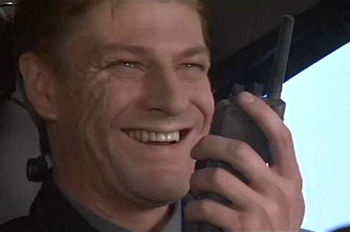 Like Licence to Kill, GoldenEye is ultimately a tease that suggests that there will be a little more substance to this Bond caper before it falls back on the usual tropes. Missed opportunities abound: Trevelyan is a former double-oh operative, which should lead to a rousing war of wits with Bond since he knows all there is to know about MI-6, but all it amounts to is Trevelyan taking Bond’s watch away when he’s captured. A tense confrontation is set up when Bond reveals to Russian General Ourumov (Gottfried Jean), Trevelyan’s partner-in-crime, that Trevelyan is a descendant of Cossacks who helped the Nazis slaughter Russians in World War II — only the movie goes absolutely nowhere with it. The film points out the hoariness of the Bond mythos, then sits back and smirks, as if that’s all it needs to do. We may be given the promise of a Bond for the new post-Cold War age, but the present ends up looking an awful lot like the past: a megalomaniac in a tropical hideaway, a countdown to destruction.
Like Licence to Kill, GoldenEye is ultimately a tease that suggests that there will be a little more substance to this Bond caper before it falls back on the usual tropes. Missed opportunities abound: Trevelyan is a former double-oh operative, which should lead to a rousing war of wits with Bond since he knows all there is to know about MI-6, but all it amounts to is Trevelyan taking Bond’s watch away when he’s captured. A tense confrontation is set up when Bond reveals to Russian General Ourumov (Gottfried Jean), Trevelyan’s partner-in-crime, that Trevelyan is a descendant of Cossacks who helped the Nazis slaughter Russians in World War II — only the movie goes absolutely nowhere with it. The film points out the hoariness of the Bond mythos, then sits back and smirks, as if that’s all it needs to do. We may be given the promise of a Bond for the new post-Cold War age, but the present ends up looking an awful lot like the past: a megalomaniac in a tropical hideaway, a countdown to destruction.
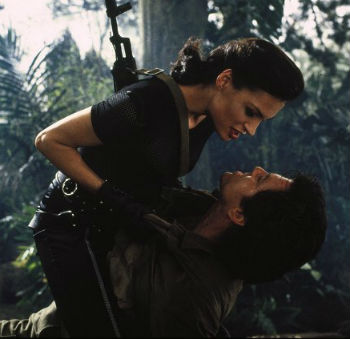 This all brings us full circle to Bond himself: GoldenEye refers to a killer satellite in the movie, but it’s also a tip of the cap to the Jamaican home of Ian Fleming, where it all started. Perhaps the filmmakers were hoping that the reference would signal a return to the character’s roots, and a rediscovery of his enduring appeal over the years. You won’t find much of that appeal, or much of anything, to the Bond in this film. Mostly he soldiers on as always, with flatter one-liners than usual. At this point, audiences were’t too picky about Bond, as long as he had the familiar outline of the character, and Brosnan certainly had that: you’ll usually find him #2 or #3 on most people’s “Best 007 actor” lists. Lips pursed, self-effacing, his eyes squinched up with worry every so often, he makes for a curiously empty Bond in GoldenEye, caught in the act of trying to figure out who he is. A ton of put-downs are hurled his way, and he never responds, which might be appropriate (Bond was never one for psychoanalysis), but it renders him inert. Boilerplate as he (and the movie) are, moviegoers didn’t seem to mind — teamed up with an immortal Nintendo 64 game, GoldenEye the movie was a rousing success at the box office, reviving the fortunes of the Bond franchise, and thereby setting a course that would dominate for the rest of the decade: a retreat to familiarity, spruced up by the illusion of change. Meet the New World, same as the Old World.
This all brings us full circle to Bond himself: GoldenEye refers to a killer satellite in the movie, but it’s also a tip of the cap to the Jamaican home of Ian Fleming, where it all started. Perhaps the filmmakers were hoping that the reference would signal a return to the character’s roots, and a rediscovery of his enduring appeal over the years. You won’t find much of that appeal, or much of anything, to the Bond in this film. Mostly he soldiers on as always, with flatter one-liners than usual. At this point, audiences were’t too picky about Bond, as long as he had the familiar outline of the character, and Brosnan certainly had that: you’ll usually find him #2 or #3 on most people’s “Best 007 actor” lists. Lips pursed, self-effacing, his eyes squinched up with worry every so often, he makes for a curiously empty Bond in GoldenEye, caught in the act of trying to figure out who he is. A ton of put-downs are hurled his way, and he never responds, which might be appropriate (Bond was never one for psychoanalysis), but it renders him inert. Boilerplate as he (and the movie) are, moviegoers didn’t seem to mind — teamed up with an immortal Nintendo 64 game, GoldenEye the movie was a rousing success at the box office, reviving the fortunes of the Bond franchise, and thereby setting a course that would dominate for the rest of the decade: a retreat to familiarity, spruced up by the illusion of change. Meet the New World, same as the Old World.

